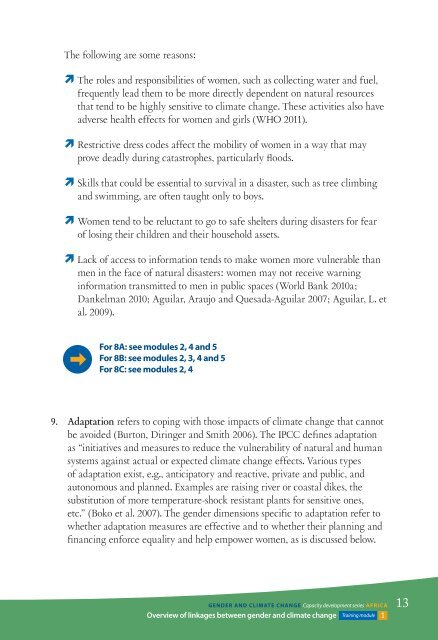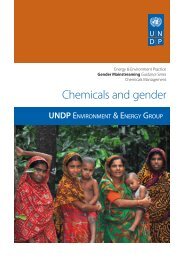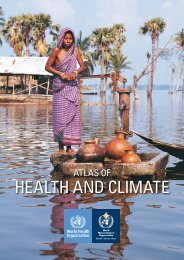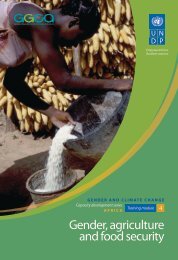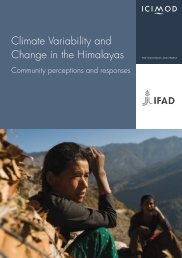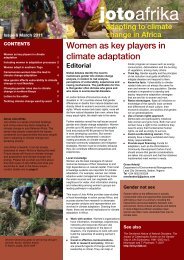Overview of linkages between gender and climate change
Overview of linkages between gender and climate change
Overview of linkages between gender and climate change
You also want an ePaper? Increase the reach of your titles
YUMPU automatically turns print PDFs into web optimized ePapers that Google loves.
The following are some reasons:<br />
ÒÒThe roles <strong>and</strong> responsibilities <strong>of</strong> women, such as collecting water <strong>and</strong> fuel,<br />
frequently lead them to be more directly dependent on natural resources<br />
that tend to be highly sensitive to <strong>climate</strong> <strong>change</strong>. These activities also have<br />
adverse health effects for women <strong>and</strong> girls (WHO 2011).<br />
ÒÒRestrictive dress codes affect the mobility <strong>of</strong> women in a way that may<br />
prove deadly during catastrophes, particularly floods.<br />
ÒÒSkills that could be essential to survival in a disaster, such as tree climbing<br />
<strong>and</strong> swimming, are <strong>of</strong>ten taught only to boys.<br />
ÒÒWomen tend to be reluctant to go to safe shelters during disasters for fear<br />
<strong>of</strong> losing their children <strong>and</strong> their household assets.<br />
ÒÒLack <strong>of</strong> access to information tends to make women more vulnerable than<br />
men in the face <strong>of</strong> natural disasters: women may not receive warning<br />
information transmitted to men in public spaces (World Bank 2010a;<br />
Dankelman 2010; Aguilar, Araujo <strong>and</strong> Quesada-Aguilar 2007; Aguilar, L. et<br />
al. 2009).<br />
For 8A: see modules 2, 4 <strong>and</strong> 5<br />
For 8B: see modules 2, 3, 4 <strong>and</strong> 5<br />
For 8C: see modules 2, 4<br />
9. Adaptation refers to coping with those impacts <strong>of</strong> <strong>climate</strong> <strong>change</strong> that cannot<br />
be avoided (Burton, Diringer <strong>and</strong> Smith 2006). The IPCC defines adaptation<br />
as “initiatives <strong>and</strong> measures to reduce the vulnerability <strong>of</strong> natural <strong>and</strong> human<br />
systems against actual or expected <strong>climate</strong> <strong>change</strong> effects. Various types<br />
<strong>of</strong> adaptation exist, e.g., anticipatory <strong>and</strong> reactive, private <strong>and</strong> public, <strong>and</strong><br />
autonomous <strong>and</strong> planned. Examples are raising river or coastal dikes, the<br />
substitution <strong>of</strong> more temperature-shock resistant plants for sensitive ones,<br />
etc.” (Boko et al. 2007). The <strong>gender</strong> dimensions specific to adaptation refer to<br />
whether adaptation measures are effective <strong>and</strong> to whether their planning <strong>and</strong><br />
financing enforce equality <strong>and</strong> help empower women, as is discussed below.<br />
Gender <strong>and</strong> Climate Change Capacity development series Afric a<br />
<strong>Overview</strong> <strong>of</strong> <strong>linkages</strong> <strong>between</strong> <strong>gender</strong> <strong>and</strong> <strong>climate</strong> <strong>change</strong> Training module 1<br />
13


